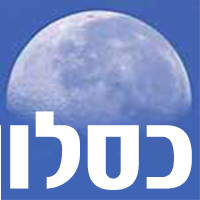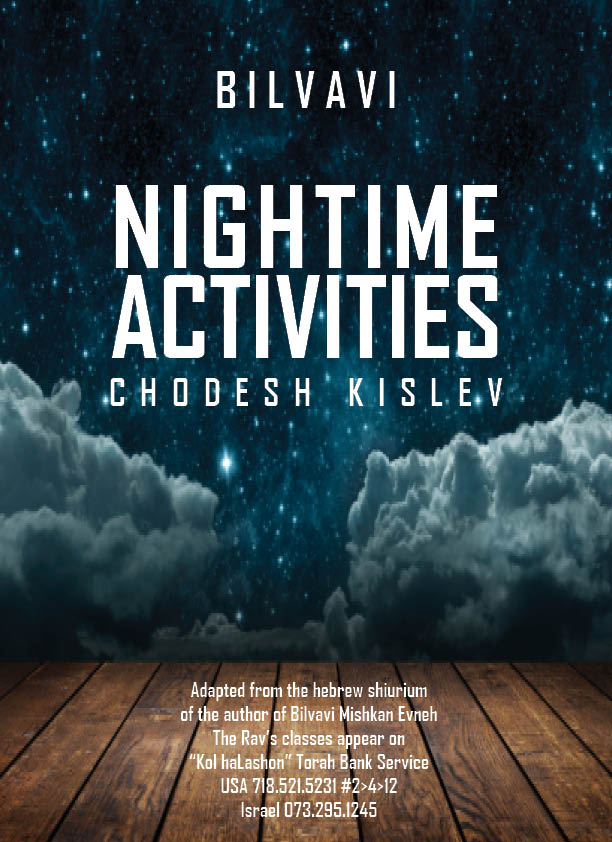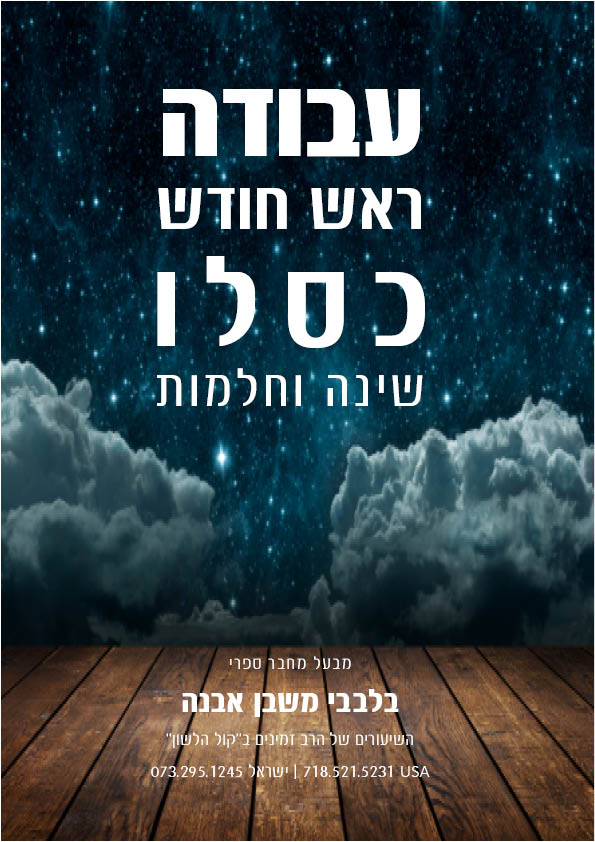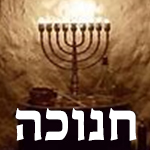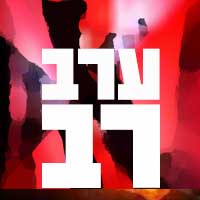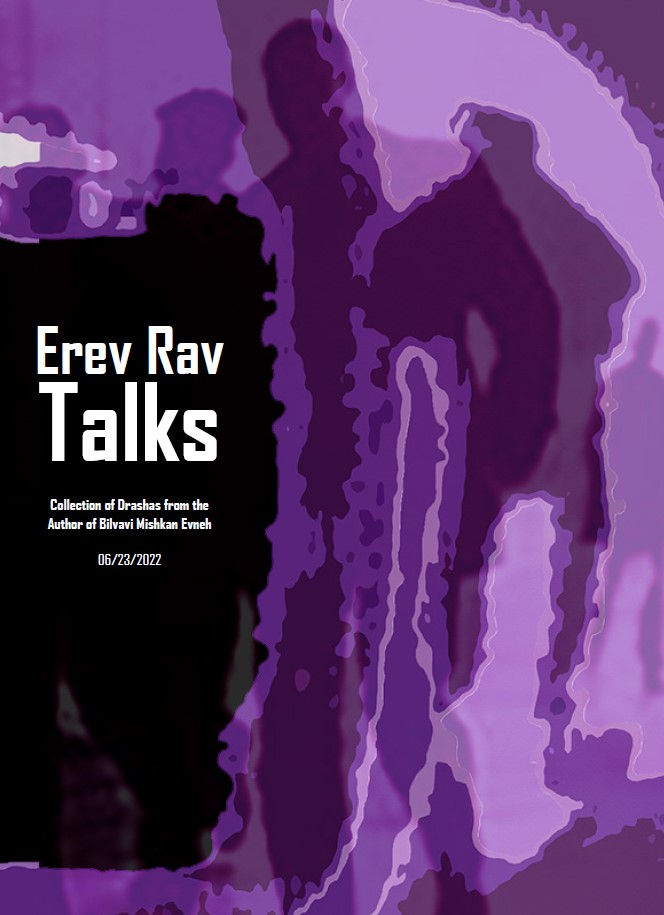- להאזנה ראש חודש מזל 015 אדר מזל דגים
015 Adar | Fish
- להאזנה ראש חודש מזל 015 אדר מזל דגים
Rosh Chodesh Mazal - 015 Adar | Fish
- 12785 reads
- Printer-friendly version
- שלח דף במייל
Why Haman Rejoiced
The mazal[1] of the month of Adar, as is well-known, is dagim – fish.
There is a well-known Gemara: When Haman cast lots (purim) in order to decide which month to destroy the Jewish people, it landed on the month of Adar, the month where Moshe Rabbeinu left the world, and therefore he grew very happy, taking this is a sign that it will be a month of bad mazal for the Jewish people.[2]
Elsewhere, Chazal state a different reason of why Haman rejoiced. In the words of the Midrash in Esther Rabbah, Haman was happy that the lot fell on Adar because the mazal of Adar is fish, and fish can be swallowed.[3]
The Gemara elsewhere says that “Just as big fish swallow the smaller fish, so would people swallow each other, if not for fear of the government”. Amalek did not fear Hashem when they attacked the Jewish people in the desert. They were missing fear of a higher authority, so they did not care to swallow others. Haman, who descended from Amalek - the nation that does not fear Hashem – was ready to ‘swallow’ the Jewish people, for his lot landed on the month of Adar, the mazal of fish, which can get swallowed alive. Thus, we can now better understand why Haman rejoiced when the lot that he cast fell on the month Adar.
What was Haman’s downfall? Chazal say that Haman overlooked the fact that “Just as fish can swallow, so can they be swallowed.”[4] Let us reflect a little into the depth of Haman’s downfall, and on the deeper meaning of how fish can both swallow and be swallowed. What is the depth of this matter that fish can swallow and also be swallowed?
Haman Thought That The Light of Moshe Rabbeinu Cannot Protect Us In Adar
Haman was happy because he thought that in the month of Adar, he will be able to ‘swallow’ the Jewish people. Let’s analyze this further.
The Gemara says that “the fish do not meet the sunlight, because they are always covered by the water. There is also a Gemara that says that “The face of Moshe is like the face of the sun.”[5] In other words, the spiritual light of Moshe Rabbeinu, which is compared to the sunlight, cannot reach where the fish are.
Thus, the depth of why Haman rejoiced was not simply because it was the month where Moshe expired (as is well-known, Moshe expired on the 7th of Adar, and the number 7 in Hebrew is ז, which is equal in gematria to the word דג\fish). Rather, it is because the spiritual power of Moshe is compared to the sun’s light, which does not reach the fish.
That is the depth of why Haman rejoiced: since the mazal of Adar is fish, he thought that Moshe Rabbeinu’s merits would not be able to protect the Jews in the month of Adar, because the light of the “sun” cannot reach the “fish”. So it wasn’t simply because Adar was the month where Moshe left the world; it was because even if Moshe were to have remained alive in the month of Adar, his light cannot reach the “fish”. This insight made Haman confident that in the month of Adar, he will be able to destroy all the Jews.
Haman Thought He Is The ‘Big Fish’ Who Will Swallow All of the ‘Little Fish’
There is yet a deeper understanding of why Haman rejoiced because he thought he could swallow the Jewish people in Adar.
The Gemara says that “by way of the world, the big fish can swallow little fish”. When the lot that he cast landed on the month of Adar, which has the mazal of fish, Haman understood this to mean that he will be like a “big fish” who can swallow all the of little fish, which he thought was represented by the Jewish people. After all, the law of nature is that the big fish swallow the little fish, and not the other way around. Haman didn’t dream of a possibility that perhaps all of the ‘small fish’ will swallow the ‘big fish’, because that goes against the laws of nature. The mazal of fish is that they can get swallowed by bigger fish; so Haman thought that he is for sure the “big fish” that can come and ‘swallow’ all of the “little fish”.
What Haman Didn’t Realize
Based upon the above understanding, we can now proceed to understand the following. What is the root of the disadvantage contained in the concept of fish?
The Gemara[6] says, “Where do we find a hint to Haman in the Torah?” and the Gemara answers from the verse,"המן העץ הזה", “HaMin HaEitz HaZeh”, (“From this type of tree”), which is said regarding the Eitz HaDaas (the Tree of Knowledge of Good and Evil). Regarding the sin with the Eitz HaDaas, one of the opinions in the Gemara is that it was dagan, a kind of grain. The word “dagan” (דגן) is a combination of the word dag (דג) and the letter nun (נ) which is equal to “50”. In Aramaic, the word dag\fish is called “nunei”, similar to the letter nun, which further hints to the connection between fish and the number 50.
The Gemara[7] asks, “Where is a hint to Moshe from the Torah?” The Gemara answers that it is contained in the verse,"בשאגם הוא בשר", when Hashem wanted to destroy of all mankind, by the decree of the Mabul[8]; the Gemara saysthat the fish survived the Mabul. Herein contains the root of how the Jewish people could be saved. Haman thought that he could swallow all of the ‘fish’, the Jewish people, because the mazal of Adar is fish. But he didn’t realize that the fish were saved from the Mabul, when the rest of the world had been destroyed. Herein lays the downfall of Haman.
The Depth Behind The Fish That Swallowed Yonah
We can also understand it further. Where do we find the concept that the fish swallow others? There was a big fish that swallowed the prophet Yonah, who refused to listen to Hashem’s command to admonish the people of Ninveh. Hashem sent a big fish to swallow Yonah – here we see a concept in which a big fish can come and swallow a person.
The Sages explain that at first, when Yonah was swallowed by the big fish, he was enjoying it there, so Hashem made the big fish spit him out and then he was swallowed by a small fish.[9] From this we can see that not only can a big fish swallow a person, but even a small fish can swallow that which is bigger than it. Now we can better understand that the Jewish people were truly in danger. If even a small fish can swallow a person, surely the Jewish people were in danger of being swallowed by a ‘fish’ – whether the ‘fish’ is big or small.
There is a verse, “From the stomach, the grave, I was rescued.” As long as Yonah was in the big fish, Chazal say that it was like Gan Eden to him, and he had it all good there. When he was swallowed by a small fish, which Rashi identifies as a female fish – this represents the place that is “from the stomach, the grave, I was saved.” Normally it is a big fish which swallows a small fish, but with Yonah, a small fish swallowed something that was bigger than it. The fact that Yonah could be swallowed by a small fish is the root of the downfall of Haman, who wanted to swallow us.
The Tzaddikim Will Eat The Leviathan In The Future: The Root of Haman’s Downfall
Let us explain this more.
It is brought in Pirkei D’Rebbi Eliezer, and in other places in Chazal, that when the fish swallowed Yonah, after some time the fish said to Yonah, “My time has come to be swallowed by the leviathan.”[10] Later when Yonah met the leviathan, he said to it, “Know that in the future, Hashem will make a festive meal for the tzaddikim, and what will be served in that meal? You!” Immediately the leviathan fled. What is the depth of this?
Normally, it is the bigger fish which swallow the smaller fish. Who is the biggest fish that swallows the smaller fish? The ultimate “big fish” that exists is the leviathan, which is called the ‘king of all fish’. It is the ultimate swallower. At the meal for the tzaddikim in the future, the “seudah of the leviathan”, it will be revealed that the one that swallows (the leviathan) is the one that will be swallowed.
This concept took place in the side of evil with Yonah, where it was not only a big fish which swallowed him, but even a small fish was able to swallow him. Afterwards when Yonah was saved, whereupon he said “From the stomach, from the grave, I was rescued”, and it came time for the fish to be eaten by the leviathan, what did Yonah say to the leviathan? He said to it, “We, the tzaddikim, will be the ones to eat you in the future.” From here we see the concept that the biggest fish of all, the leviathan, will be swallowed by the tzaddikim.
The Depth of The Danger: Man Can Be ‘Swallowed’ By ‘Fish’
There are two extremes to how this concept manifests in the side of evil.
At first we explained the simpler manifestation of this concept, in the side of evil: the fact that a big fish can swallow the smaller fish [which hints to how the Jewish people were in danger from Haman].
But this was not that much of a worry for the Jewish people, because we see that Yonah was enjoying it inside the belly of the big fish. The fact that a ‘big fish’ was threatening to swallow the Jewish people was therefore not such a threat to them, because it is still possible to survive after being swallowed by the ‘big fish’ – and be in a Gan-Eden like state, as Yonah was.
What, then, was the great danger to the Jewish people? It is from the fact that Yonah could be swallowed by a small fish, which he wanted to be saved from – of which he said, “From the stomach, from the grave, I was rescued.” So the Jewish people were truly in danger from the fact that Haman wanted to swallow them.
Haman is called “this oppressive man, this enemy”, to the Jews. He was the “big fish” that wanted to destroy all of the “small fish”, the Jewish people - just as Yonah was suffering when he was swallowed by the small fish. But it was not simply because the “big fish” can swallow the “small fish”. It was because even the small fish can swallow that which is bigger than it.
[Thus there was a very great danger to the Jewish people, because if there is a concept that even a small fish can swallow a person (like what happened with Yonah) – which is even worse than being swallowed being a big fish (and that is what happened with Yonah) – then the Jewish people were in very great danger from the ‘fish’, Haman, who is trying to ‘swallow’ them.]
What happened in the end? Everything was turned around for the better of the Jewish people. It reflected the state of the future, where the tzaddikim will eat the biggest fish of all, the leviathan – and so they were able to ‘swallow’ Haman, the ‘big fish’.
This is the depth of the words of the Midrash in Esther Rabbah that we mentioned in the beginning, that Haman rejoiced when the last that he cast fell on Adar, which has the mazal of Adar, for fish can be swallowed. He knew that not only can a big fish swallow the small fish, but that even the small fish can swallow that which is bigger than it; thus he was truly an enemy who was endangering the survival of the Jewish people.
What he failed to realize was that just as there is a possibility that they can be ‘swallowed’ by him, so can there be a possibility that they can ‘swallow’ him. And how indeed did the Jewish people have the power to ‘swallow’ him? It is not in the same way that a big fish can swallow a small fish. Rather, it is in the same way that the tzaddikim in the future will swallow the leviathan, the biggest fish of all.
The Torah Of The Future: A Level Beyond The Five Parts of The Torah
Haman built a gallows for Mordechai that was 50 amos high. The letter nun (נ) is equal to 50, which is similar to the Aramaic word “nunei”, which we mentioned earlier, in connection with the Hebrew word dag (fish). In the end, it was Haman who was hung on it, and this reflects the future, when the “big fish”, the leviathan, will be eaten by the tzaddikim.
The Gemara[11] says that eating fish [on too much of a regular basis] is detrimental for the eyes. This can be connected with a statement of the Sages that “the eyes see, and the heart desires”,[12] which connotes that the eyes see forbidden sights and they become damaged spiritually; the root of this began ever since Chavah laid her eyes upon the Eitz HaDaas. Elsewhere, the Gemara says that “nunei samei eina”, “fish are a remedy to the eyes.”[13] How do we reconcile these contradicting statements?
The word nunei contains three letters (נני), and elsewhere the Gemara explains that the three consecutive letters of נ, ס, ע are a hint that nunei\fish are a sam\remedy to the eyes. Let us understand this deeply. In the side of evil, the lettersס and מ (the word sam\סמ) is placed in between the letters of ס and ע, which is the word סומא, blindness, of the eyes; this refers to the concept of how fish are bad for the eyes. But in the side of holiness, “fish” are good for the eyes; we see this from fish of Yonah. The Gemara says that its eyes became windows, and Yonah was able to see the entire ocean through it. This is how “fish” are good for the eyes, nunei same eina – “fish are remedy (סמא) for the eyes.”
The lettersנ ס ע form the word נסע, which we find in the verse of the Torah of ויהי בנסוע הארון, when “the Aron (Ark) journeyed forth in desert”.[14] The Gemara says “the Aron is [contains] a sefer in and of itself”, apart from the five parts of the Torah that are the Chumash. This is related to the concept of how nunei (fish) is the sama (remedy) of the eina (eyes), because it contains the letters נסע, which stands for“nunei sama eina”. Let us explain.
The mazal of Adar is fish, so Haman rejoiced when the lot that he cast fell on Adar; the word for “rejoiced” here is שמח which has the letters חמש alluding to the Chumash (the five parts of the Torah). In other words, Haman can only have power of us if our Torah is on the level of Chumash, which is represented by the number 5.
But the mazal of fish represents a level that is above the number 5, for “fish are remedy the eyes”, (“nunei sama eina”), and the “nunei sama eina” (which is represented by the word נסע) by the Aron represents “a sefer in and of itself”, which means that there is another sefer besides for the 5 parts of the Chumash. In addition to this, the Gemara also says that besides for how the sefer contained in the Aron was a unique sefer in and of itself, there is also another sefer of the Torah – the sefer that is formed by those who learn the Torah. So altogether there are 7 parts to the Torah – the 5 parts of the Chumash, the sefer that was in the Aron, and the sefer that is formed by those who learn it. Thus, through the concept of “nunei sama eina” (represented by the word נסע) which we find by the Aron, a new sefer is revealed. This shows us that power of nunei, fish, represents a whole new level of Torah – a level in which there are 7 parts to the Torah, and not 5 - which is what protected us from Haman.
In the time of Purim, the nation accepted the Torah willingly again, “out of love from the miracles”, as Rashi says. Haman wanted to swallow the Jewish people, but in the end it was they swallowed him. Herein lays the root of the light of the Torah that will be revealed in the future, which will go from 5 parts of Torah to 7; this was revealed on Purim. It revealed a new acceptance of Torah, a new sefer that was separate from the five parts of the Chumash – which is contained in the concept of “nunei sama eina”, represented by the word נסע, in the verse of ויהי בנסוע הארון.
Moshe told Yehoshua to write in a sefer of the events of the war with Amalek, as a remembrance. What is this sefer? It is the “new sefer” of the Torah which is apart from the Chumash, which will be revealed in the future - when the Torah will go from the 5 parts to 7 parts.
The Depth of the Purim Seudah: A Resemblance of the Seudah of the Leviathan
The seudah that we eat on Purim is called “mishteh v’simcha”, of celebration and joy. The Gemara says that we have oneg Shabbos (pleasure on Shabbos) by eating big fish. But the seudah of the leviathan in the future will not just be a meal of eating big fish like we have today, because the leviathan is the biggest fish ever. Shabbos is called “a resemblance of the World To Come”, where we rejoice by eating big fish. The meal of the future, however, will be the “World To Come” itself, and it will not be with just big fish, but with the biggest fish ever - the leviathan.
On Purim, when we have a seudah of mishteh v’simchah, where we “celebrate the downfall of that wicked one”, it is really a resemblance of the seudah of the leviathan.
The Gemara says that Hashem created two leviathans – a male and a female. Hashem castrated the male leviathan and killed the female; there would be no marital connection between the male and female leviathan. Marital connection is called da’as, as the possuk says by Adam and Chavah, “And Adam knew (va’yeda) his wife”, which refers to conjugal relations. There will be no daas between the male and female leviathan, because there will only be one of them. This is the depth of the seudah we eat on Purim, in which there is an obligation upon a person to become inebriated to the point of ad d’lo yoda, of having no more daas. It is reflects the seudah of the future where the tzaddikim will eat of the leviathan - where there will be no daas.
As is well-known, Purim is a light of the future. Purim will never cease, unlike the other festivals. The depth of this is because the seudah of Purim is a revelation of the seudah of the leviathan that will be in the future; Purim is a resemblance of it. The seudah of the leviathan, which we resemble in the seudah we have on Purim. Haman wanted to ‘swallow’ us, and in the end, it was us who ‘swallowed’ him. We ‘swallowed’ Haman – and that is the root of the future seudah of the leviathan, where the tzaddikim will all swallow the ‘big fish’.
The Secret of Haman’s Downfall – The “New Sefer” of Torah That Was Contained In The Aron
In the parsha in the Torah of ויהי בנסוע הארון, there are two places where the letter נ appears. There is a regular נ at the beginning of the parsha, and there is an upside-down נ at the end of the parsha. At first Haman built a gallows of 50 amos to hang Mordechai on, and in the end Haman, it was hung on it; this is the hint contained in the upside-downנ – it hints to us that Haman’s plans involving the number “50” (the gallows which he prepared for Mordechai which was 50 amos high) were turned upside-down on him, so his own plans were turned on him. Thus, it is the parsha of ויהיבנסוע הארון which contains the secret to Haman’s downfall. From the power of the special sefer of Torah that was inside the Aron, came Haman’s downfall – it is the “new Torah” of the future, whose light was revealed on Purim, which saved the Jewish people from Haman and which destroyed him, using Haman’s own “50” that he had planned.
Thus, the light revealed on Purim is represented by the fish, particularly in the concept of nunei sama eina, “the fish are remedy to the eyes”. The “nunei”, the fish, brought about our reason to eat the seudah of the Purim (as explained until now) - where we celebrate the downfall of Haman, in which the power of “fish” was turned against him. It is all a resemblance of the seudah of the leviathan in the future.
This is the great spiritual “light” of Purim that came to the Jewish people, which the Megillah describes as orah, the “light”, that came to the Jewish people then. This was really the light of the new revelation of Torah of the future, which was contained in the sefer that was inside the Aron.
The ‘Fish’ and ‘Wine’ Of Purim
This is also the root of why there is an obligation to drink wine on Purim. Wine in Hebrew is יין, which is equal in gematria to the number 70, which parallels the number 7; as mentioned earlier, the number 7 is the level of the future Torah, in which the Torah will go from 5 parts to 7 parts.
On Purim, there is both eating and drinking. We eat fish and we drink wine at the Purim seudah. Eating the fish at the Purim seudah is a reflection of how the tzaddikim will eat the leviathan in the future. We also have wine on Purim, which also reflects the “wine” that will be served in the seudah of the future. These two aspects resemble the seudah of the leviathan in the future, where there will be “fish” [the new revelation of Torah, which is the secret of “fish is remedy to the eyes”] and “wine” [the future Torah, which will have 7 parts, parallel to the “70” of יין\wine].[15]
At the seudah of the leviathan in the future, there will only be one fish in the world, and there will be no connection of daas between the male and female leviathan, because there will only be one leviathan; [for there will be no more daas – it will go beyond our daas].
This is the depth of “One is obligated on Purim to become inebriated to the point of ad d’lo yoda, (until he does not ‘know’)”…..
[1] astrological sign
[2] Megillah 13a-13b
[3] Esther Rabbah 7:11
[4] Esther Rabbah ibid
[5] Bava Basra 87b
[6] Chullin 139a
[7] ibid
[8] The Deluge
[9] Pirkei D’Rebbi Eliezer 10, Midrash Tanchuma: Vayikra: 8
[10] The “leviathan” (in Hebrew, livyasan) is often translated as the “whale”. The Sages state that Hashem created two of these giant whales, one of them a male and a female. The female whale was so strong that it could have destroyed the world. Therefore, Hashem killed it and salted its meat for the future, when the tzaddikim will enjoy the “seudas halivyasan”, the “festive meal of the leviathan”. Understandably, this is not referring to a physical pleasure, but to a spiritual bliss that goes beyond our comprehension.
[11] Talmud Bavli: Berachos: Chapter Nine
[12] Bamidbar Rabbah 10:2
[13] Nedarim 54a
[14] Bamidbar 10:35
[15] A similar insight to this is brought in sefer Nezer Yisrael vol. II: Moadim, of Rav Avraham Tzvi Kluger shlit”a.
NOTE: Final english versions are only found in the Rav's printed seforim »


